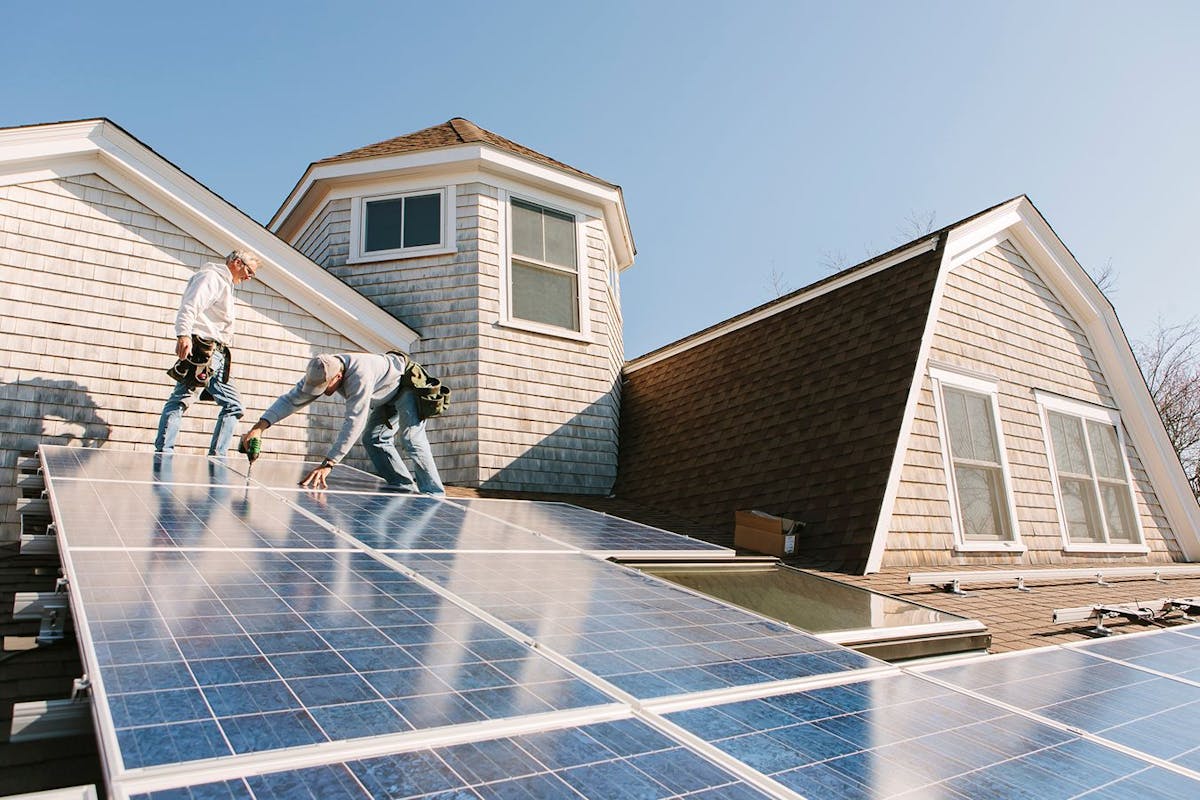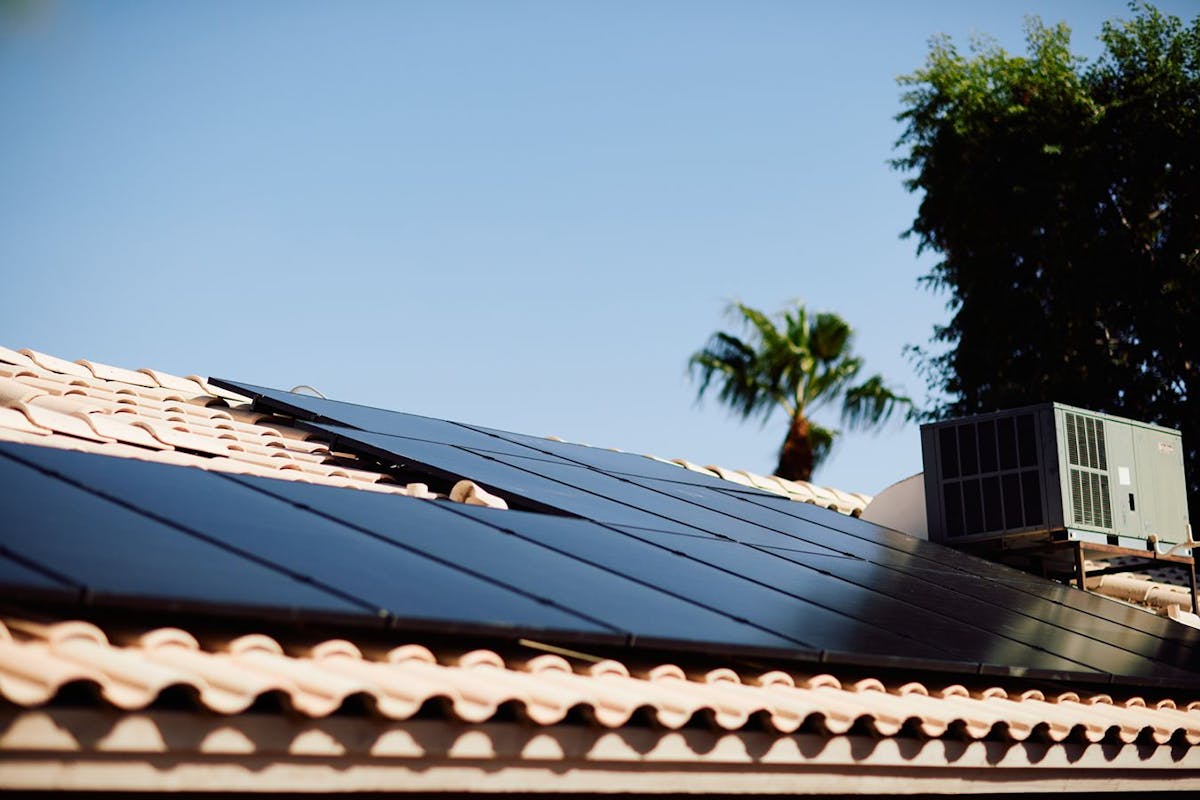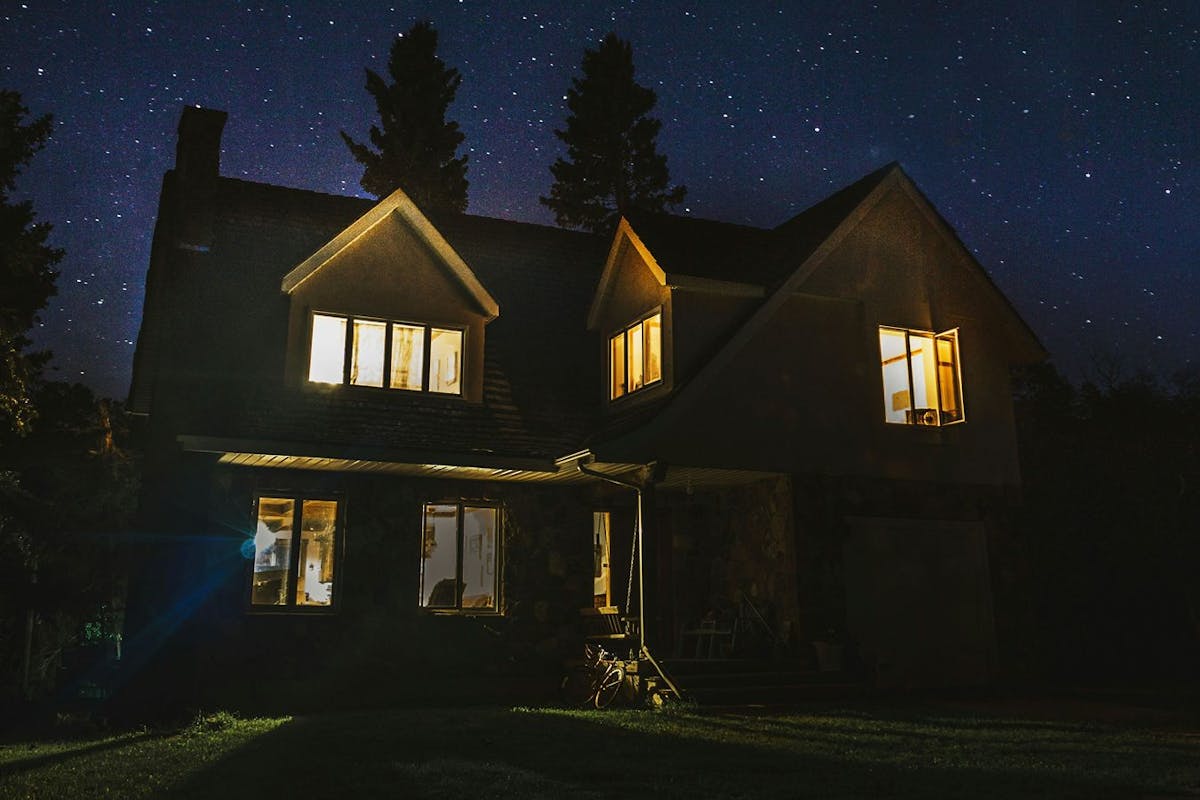How Many Solar Panels Do I Need?
Last edited

Author
Andrew Giermak
Solar and Electrification Writer and Editor

Editor
Andrew Blok
Electrification and Solar Writer and Editor

Millions of Americans have installed home solar panels to reduce their bills and increase their independence. But how did they know how many solar panels they needed?
Almost all of them worked with a solar installer that helped them with those calculations, and that's the best way to go. If you want to get an idea for yourself, we've got you covered below.
Or, download the Palmetto app to see how much energy your home consumes and what a new solar system can do for you
See how much you can save by going solar with Palmetto
Determining How Many Solar Panels a System Needs
A typical home needs 18-26 solar panels to cover 100% of its electricity usage. While there are many elements you can analyze to determine the ideal size of your future system, these four are most worth your time.
- Your household energy consumption
- Peak sun hours for your area
- Output of each solar panel
- Your solar goals
Here's a deeper look at each of these elements.
Energy consumption
When people begin thinking about home solar, the questions they ask are often similar:
- "How much energy does a solar panel produce?"
- “How many solar panels can I fit on my roof?"
- "How large of a solar system do I need?"
- "How many panels are needed to power a house?"
When determining the number of panels you need, it boils down to one factor: The amount of energy you use (or plan to use) in your home.
To figure out the right number of solar panels for your house, you should first determine how much electricity you use during an average month. Start with your last 12 monthly electric bills, add up your total usage in kilowatt-hours (kWhs) and divide by 12.
Both your 12-month total energy consumption and your 12-month average energy consumption are the baseline information you need about your energy consumption, because everything else depends on your electricity usage.
Peak sunlight hours
Solar panels rely on direct sunlight to generate electricity. To perform as efficiently as possible, panels need maximum sustained exposure to sunlight, a concept called peak sun hours. Where you live is a factor in how much energy your solar panels will produce in a day. For example, the American southwest regularly receives well over six hours a day of peak sun hours, while the American northwest struggles to get four.
The best way to learn the amount of sustained sunlight your area receives is to speak with a solar energy system expert, like the ones at Palmetto. You can also consult the U.S. State Solar Resource Map from the National Renewable Energy Laboratory.

Credit: NREL
Solar panel output
Different solar panels have different electricity generation capabilities, based on factors that include the number of solar cells per panel and whether they are efficient panels. Additionally, how many square feet of space is available, a panel's installation direction, and shade from trees or a chimney may impact how much electricity your solar panels produce.
Electrical output also depends on the angle of installation. Solar panels for your home are installed in a solar array, which is just a group of solar panels installed together. The simplest array to install is a single rectangular shape. However, a single rectangular array requires a basic rectangular roof for suitable installation, so it’s incompatible with complex roof designs.
If your home features an unusually-shaped roof that doesn’t allow for a single array that meets your solar needs, the correct number of panels for your home will instead be arranged in multiple groups in different areas of your roof. If different arrays face in different directions, their electricity output will vary due to differing exposure to sunlight, even if the panels are identical.
Your solar goals
People switch to solar for different reasons. Some want to save money on electricity costs and energy bills, others want to have a plan to avoid utility brownouts or power outages, and others want to minimize their carbon footprint and use clean, renewable energy. Those are all good considerations to help you determine the number of panels to achieve your desired power output.
Let’s consider three common options.
- If you plan to participate in net metering, you may want to install solar panels that can generate more electricity than you consume. This allows you to receive credits for excess electricity production and realize the maximum amount of savings on your energy costs.
- If avoiding power outages is your goal, a good solar battery storage system will ensure you store enough electricity that you can use later. You'll have a dependable and independent reserve of electricity.
- If you want to use solar to help the planet, you will need enough solar panels to produce 100% of your electricity needs so you don’t consume dirty electricity from the utility. This option also allows you to save money and be more energy independent.
Having a clear goal makes it easier for you and your solar installer to arrive at the right number of solar panels for your home.
See how much you can save by going solar with Palmetto
How Can I Calculate the Correct Size of My Solar Panel System?
Palmetto has a solar savings calculator to help customers estimate the size of the solar energy system they need and energy savings.
Alternatively, you can use a formula to determine the system size you need to power your house:
(Monthly electricity usage / Monthly peak sun hours) x 1,000 / Solar panel wattage = Number of solar panels
Let's break this formula down in more detail.
Determine your energy consumption
Total the last 12 months of usage from your electricity bills and divide by 12 to get your home's monthly average. For our purpose here, we will use 1,200 kWh per month as an example.
Determine how much sunlight you receive in your area
You need to know the peak sun hours your area receives. Keep in mind, average daily peak sun hours aren’t merely the hours when the sun is in the sky. They are the hours when the sun delivers the most sustained exposure of sunlight, which means the hours when your solar panels will be most productive.
Peak sun hours directly impact the number of solar panels you need. If you live in a place that receives a lot of sunlight, such as Arizona, a smaller solar power array might fulfill all your needs. You would need a bigger system to achieve the same amount of energy production if you live in an area with less available sunlight, such as Massachusetts.
For our example, we will use Arizona, which receives an average of 7.42 peak sun hours per day.
Plug consumption and peak sun hours into the formula
1,200 kWh / (7.42 × 30) = 5.4 kW solar system
Note: We multiplied Arizona's average peak sun hours by 30 to get a ballpark estimate of peak sun hours the state gets per month.
Convert kW to total watts
Since 1 kW equals 1,000 watts, we will multiply 5.4 kW by 1,000:
5.4 × 1,000 = 5,400 Watts
Determine the generation capacity of your potential solar panels
Different solar panel designs have different power generation capacities, according to expected solar panel output efficiency. Panel wattage is one factor that determines the number of panels needed. 400 W panels are a common size installed by Palmetto
We'll use 400 watts for this example. Divide the total watts above by the wattage output of a single solar panel to determine how many solar panels you will need:
5,400 / 400 = 13.5 solar panels needed to cover total electricity usage
In this example, the homeowner would need a system with 14 solar panels to provide all of their energy needs. Solar installers typically factor in many additional variables when sizing a solar power system; however, this number provides an appropriate baseline when thinking about your own solar power plans.
When you work with Palmetto to design your perfect solar power system, we do the bulk of the heavy lifting, including considering the solar panel type, panel wattage, roof space, production ratio, energy usage vs. energy bills, and estimated energy output, to find out how many solar panels you need. We provide a comprehensive assessment, so you don't have to worry about the details of too many or too few panels.
The Number of Solar Panels You Need Depends on You
You now have an idea of the solar system size you need to power your home. Great! There are a few more details to set yourself up for success, including your budget and solar goals. We recommend you engage a solar professional to address the following questions about solar array size.
How many solar panels do I need for my roof design?
The design of your roof determines how the solar panels will be installed, and how much sunlight they will get. If your roof is well-angled and features enough usable roof space, it can accommodate more panels and a large solar panel system. If there is only a small available area, you may be forced to install a reduced system with costlier panels to generate the solar power you want.
The direction your roof faces also impacts the amount of sunlight your solar panels will receive. Better exposure (typically south-facing) requires fewer solar panels. However, if your roof faces in a direction that receives less sunlight, your solar company might have to adjust the orientation of your system to provide sufficient electricity.
How many solar panels do I need for home appliances?
Do you know how much power you're using each month? Just knowing the monthly energy consumption on your power bill isn't always enough to help you make the right decision. You need to look around your house to learn where and when you use electricity, especially for your appliances.
For example, you may notice higher-than-average consumption when using a washing machine or playing video games during the daytime. Understanding how your appliances use electricity gives you insights into when you are likely to need more electricity.

Credit: US EIA
To track the energy usage for individual appliances, you can install a home energy monitor or smart plug between the outlet and the appliance. Leave the usage monitor on for a week and use that data to calculate the total number of kilowatt-hours per day your appliances use.
Home appliances with the highest average electricity consumption include:
- Refrigerator
- Heater
- Air conditioner
- Dehumidifier
- Dishwasher
- Electric oven
- Washing machine
- Dryer
- PCs (especially gaming computers)
Once you know the energy consumption of your appliances and when they’re used, you can figure out the size of the solar panel system you need to install to generate sufficient electricity for your energy usage.
How many solar panels do I need if I have a lot of trees?
The beautiful trees around your home can impact how much solar energy your solar panels generate. Even if your area enjoys a high amount of peak sunlight hours, tree coverage may diminish your total energy generation.
You may have to trim trees so your solar panels can generate as much electricity as you need, which is a more cost-effective solution than adding more solar panels. If you don’t trim them, your roof might be shaded during certain times of the day and that would require a larger system to compensate for the decreased production.
Sometimes you can’t trim trees to improve your energy production, such as tall trees on the edge of a neighbor’s property. In this case, your system design will have to account for this decrease in morning or afternoon production.
How many solar panels do I need for my future energy plans?
Is your electricity consumption rate likely to increase in the coming years? When assessing your solar panel requirements, you need to think about any big changes in your electricity usage that might develop. This includes purchasing an electric vehicle, a larger HVAC system, leveraging net metering, and anything else that affects the size of your electricity bill.
Key Solar Panel Installation Takeaways
There’s a lot to consider before installing solar panels on your home, however the factors we discussed will help you estimate the size of the system you need.
Once you have your system size estimate, the best way forward is to speak with Palmetto. Use our solar savings calculator to estimate how much you could save and take the first step to a solar panel system tailored to your home.
See what solar can do for you:
Frequently Asked Questions
How many solar panels do I need to power my home?
This answer starts with knowing your current and projected electricity usage. We work with you to build a system with the generation capacity to meet your needs. Energy usage, budget, utility policies, incentives, and property all go into the overall design of your system.
How many solar panels can I put on my roof?
You can put as many solar panels on your roof as will fit. This isn’t necessarily the best or most energy-efficient answer. You want your system to be a match to your energy usage and needs. You want the system to operate as efficiently as possible. This means having the right size, knowing local metering or incentive policies, optimizing specifics such as the direction and angle of the panels, and meeting your budget and your family’s needs.
What happens if solar panels make more electricity than I need?
We work with you so you understand the best answer for you before you commit to a system. If you have battery storage as part of your solar system, extra electricity will be stored in your batteries. If you don’t have battery storage, extra electricity typically goes to the utility company’s power grid. If you are sending, or using, power to and from the grid, you need to know about plans such as net billing or net metering in your state or area.


